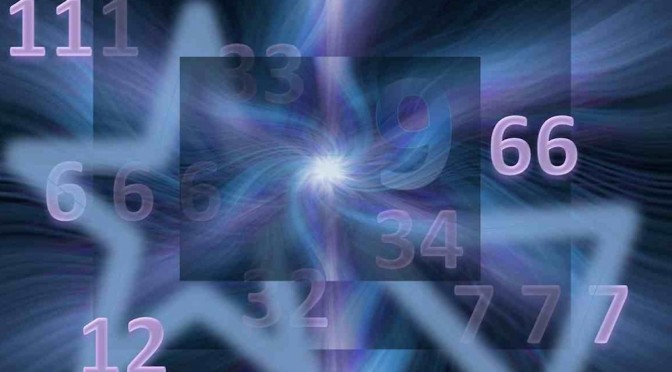Numerology has been around for a long time. Perhaps inspired by a knowledge of the Fibonacci series and the associated golden numbers Pythagoras believed that numbers and combinations of numbers had a meaning much wider than its application in arithmetic.The number 77 is a good example of the principles of numerology. It is the sum of the first eight prime numbers, and a multiple of both 7 and 11 which are Gaussian integers. This means that the multiple of these numbers is a blum integer. These terms mean that 77 is a really special number. It would take pages and pages to explain why but it is a very special number.
In numerology one rendering of Jesus Christ is the number 77!
The Value of Letters
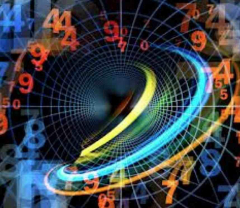 Why? Because in Numerology, every letter of the alphabet is associated with a single digit number. For instance The number 1 is associated with A, J and S the number 8 is associated with H,Q and Z.
Why? Because in Numerology, every letter of the alphabet is associated with a single digit number. For instance The number 1 is associated with A, J and S the number 8 is associated with H,Q and Z.
Therefore my own name Brian has a number B=2 R=9 I=9 A=1 N=5 = 26. A feature of numerology is that multiple numbers are added together. 2+6 =8 This final number is then associated with personal characteristics, so my name is associated with power and sacrifice. And so on and so on.
The key thing to notice here is that numerology always attempts to deliver a single digit number though double digit numbers delivered on the way can be considered significant.
Why are we into all this? Because of the church at Brenac!
Roman Numerals
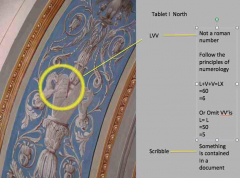 The notes alongside each graphic explore the basic application of numerology to the Roman numerals. I should point out that the numbers have to transferred from Roman numerals to arabic numerals to make numerology work. For example XIII is 13 X+I+I=I is still XIII. Roman numerals are numerology proof! 1+3 is however 4 which is how numerology is supposed to work. If we then turn 4 back into Roman numerals it becomes IV, which may or may not be useful.
The notes alongside each graphic explore the basic application of numerology to the Roman numerals. I should point out that the numbers have to transferred from Roman numerals to arabic numerals to make numerology work. For example XIII is 13 X+I+I=I is still XIII. Roman numerals are numerology proof! 1+3 is however 4 which is how numerology is supposed to work. If we then turn 4 back into Roman numerals it becomes IV, which may or may not be useful.
The Enigma
 I am not the only person to have attempted the deciphering of the Brenac tablets. However I think I am the only person to have regarded the tablets as a classical numerology enigma. Each diagram shows the conclusions for the individual tablets. I ignored the sribble on this tablet for a long time but then realised it could represent “a document”
I am not the only person to have attempted the deciphering of the Brenac tablets. However I think I am the only person to have regarded the tablets as a classical numerology enigma. Each diagram shows the conclusions for the individual tablets. I ignored the sribble on this tablet for a long time but then realised it could represent “a document”
The Triangle
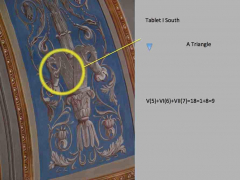 In many ways this is the most significant tablet. Aside from any issues of numerology it tells us that the issue is about a triangle. Coupled with the “scribble” in the previous slide it could tell us that we are looking for a triangle in a document.
In many ways this is the most significant tablet. Aside from any issues of numerology it tells us that the issue is about a triangle. Coupled with the “scribble” in the previous slide it could tell us that we are looking for a triangle in a document.
Because of the investigations of Henry Lincoln we know that there is such a document.
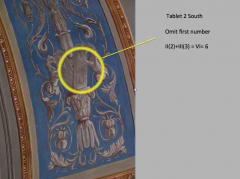 The final tablet has no options there are suggestions that the first number should be eliminated but the more obvious solution is shown here.
The final tablet has no options there are suggestions that the first number should be eliminated but the more obvious solution is shown here.
The Devil’s Number
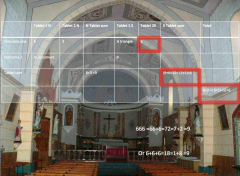 A simple summary of the findings shows how a simplistic application of numerology reveals the numbers 666, 66 , 6, 72, 7 , 2, 9, 18, 1 and 8. It gives a feel that 6, 66 and 666 are the dominant numbers as all the others are derived from them. The Devil’s numbers!
A simple summary of the findings shows how a simplistic application of numerology reveals the numbers 666, 66 , 6, 72, 7 , 2, 9, 18, 1 and 8. It gives a feel that 6, 66 and 666 are the dominant numbers as all the others are derived from them. The Devil’s numbers!
Magic Squares
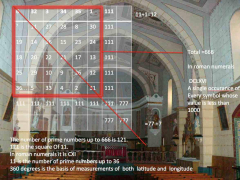 I knew that the history of numerology linked to the phenomenon called “magic squares” and after a little research I learned that 666 is one of the best known examples of this phenomenon.
I knew that the history of numerology linked to the phenomenon called “magic squares” and after a little research I learned that 666 is one of the best known examples of this phenomenon.
As can be seen in the digram a 6*6 (36 cells) table can be filled with numbers so that every line and the diagonal adds up to 111.
In numerological terms this leads to the numbers 11 and twelve- over and over again it also leads to 121 i.e 12=1 =13 and then 1=3= 4.The number 11, which occurs so frequently in this table also leads, via the occurrence of prime numbers to 36.
Sagrada Familia
 Magic squares are not obscure. To shown their mainstream usage it is necessary to return once again to the Sagrada Familia in Barcelona. This time this is a photograph not a Google 3D image.
Magic squares are not obscure. To shown their mainstream usage it is necessary to return once again to the Sagrada Familia in Barcelona. This time this is a photograph not a Google 3D image.
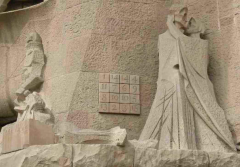 On the facade of La Sagrada Familia, the Holy Family, there is a magic square. Traditionally the Holy family was considered to be Mary, Joseph and Jesus. Mary was supposed to be both a virin and “chaste”, so what is the statue on the right of the magic square meant to represent?
On the facade of La Sagrada Familia, the Holy Family, there is a magic square. Traditionally the Holy family was considered to be Mary, Joseph and Jesus. Mary was supposed to be both a virin and “chaste”, so what is the statue on the right of the magic square meant to represent?
The magic square itself is based on the number 132 and all ten rows, columns and diagonals total 33. The Familia guide says that 33 was the age of Jesus at the time of his death.
The Fibbinnaci Series, yet again!
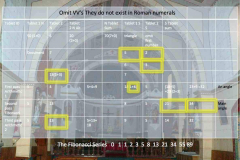 A different analysis reveals a different set of numbers. It is perfectly legitimate to suspect that almost any set of numbers can be generated from a numerological puzzle. It is like a maze but in fact there are rules to be followed and the numbers which emerged are quite surprising. All the numbers highlighted in yellow are members of the Fibonachi series which indicates the presence, perhaps even importance of a pyramid or pyramids or pentangles.( the cynical could say or credit cards!)
A different analysis reveals a different set of numbers. It is perfectly legitimate to suspect that almost any set of numbers can be generated from a numerological puzzle. It is like a maze but in fact there are rules to be followed and the numbers which emerged are quite surprising. All the numbers highlighted in yellow are members of the Fibonachi series which indicates the presence, perhaps even importance of a pyramid or pyramids or pentangles.( the cynical could say or credit cards!)
In fact the “Fibonnaci” line is not strictly numerology. It shows that all the members of the Fibbonaci series can be found in the numerological puzzle and that the next two members are 21 and 34. the presence of 18 to support the 36 from the previous analysis also indicates the presence of pentacles.
The angles of a Pentagram>
 Here are the angles of a pentacle which can be seen to be all multiples of 18. It is a very simple series itself 18,36,54,72,90,108.
Here are the angles of a pentacle which can be seen to be all multiples of 18. It is a very simple series itself 18,36,54,72,90,108.
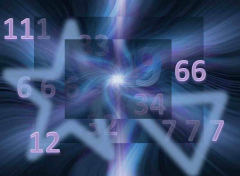 And so, after several days at Brenac Church all I had was the concept of a pentacle, a triangle and a lot of numbers. The pentacle and triangle I already knew about but not everyone coming to Brenac would have been in possession of that information.
And so, after several days at Brenac Church all I had was the concept of a pentacle, a triangle and a lot of numbers. The pentacle and triangle I already knew about but not everyone coming to Brenac would have been in possession of that information.
Of the numbers to me the most prominent was 666 followed by 66 and 9, but what did it all mean. I did not regard numerology as having any mystic significance I simply regarded it as a way of presenting as a puzzle which was intended to be solved. nevertheless the prominence of 666 did send shivers down my spine. I knew it is supposed to be the Devil’s number! Strange how this tiny attractive little church suddenly became threatening
I struggled to shrug off the feeling but in any case I had run out of time. There were other things to do. The puzzle would have to be solved back in Australia.
